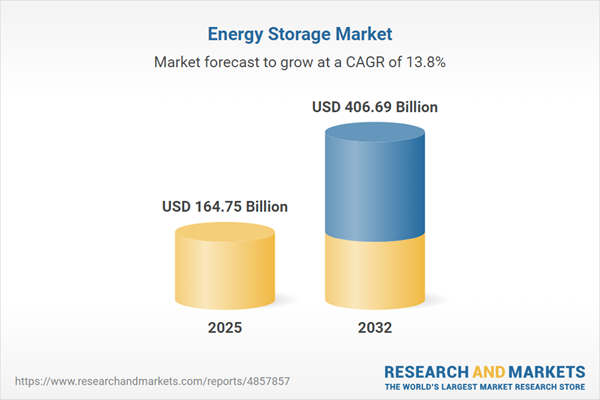Speak directly to the analyst to clarify any post sales queries you may have.
The global energy storage market is evolving rapidly as grid complexity and regulatory shifts challenge traditional approaches. Senior executives are increasingly prioritizing flexible storage solutions to ensure operational agility and long-term competitiveness.
Market Snapshot: Energy Storage Market Analysis
Driven by climbing energy demand and increasing integration of renewables, the energy storage market is demonstrating sustained expansion. Organizations invest in modern storage solutions to maintain operations during fluctuations and transition towards more distributed, adaptive grid structures. As distributed energy resources strengthen their role within utility networks, decision-makers focus on resilience and adaptability through advanced storage deployments. Regulatory developments and technology innovation, both in digital management platforms and hardware, continue to define evolving opportunities and risks. Market leadership teams remain focused on optimizing infrastructure to deliver stability and align with competitive market pressures.
Scope & Segmentation in the Energy Storage Market
Understanding critical market segments allows leaders to connect business strategies directly with operational realities and market trends:
- Technology: Solutions such as advanced lithium-ion batteries, vanadium redox flow systems, zinc bromine, and lead acid batteries are selected for their scalability, integration potential, and lifecycle performance, tailored to varied applications.
- End User: Commercial, industrial, and residential sectors implement storage systems for onsite demand management, maintaining backup capacity, and ensuring uninterrupted service under diverse operational scenarios.
- Duration: Short-duration and long-duration storage options are evaluated for their influence on grid stability, resource flexibility, and alignment with specific project delivery requirements.
- Configuration: Storage models include AC-coupled, DC-coupled, and hybrid solar-plus-storage systems, each impacting initial capital investment, operating costs, and system efficiency.
- Regional Coverage: The Americas, Europe, Middle East & Africa, and Asia-Pacific feature distinct regulatory backdrops, supply chain strategies, and adoption rates, shaping market priorities and business approaches by region.
- Company Analysis: Industry leaders such as Contemporary Amperex Technology, LG Energy Solution, Panasonic, BYD, SK On, EVE Energy, Samsung SDI, China Aviation Lithium Battery, Farasis Energy, and SVOLT provide evolving strategic models, informing competitors on effective sector navigation and partnership formation.
Key Takeaways for Senior Decision-Makers
- Adopting flexible storage technologies enhances responsiveness to changing grid conditions and supports compliance with regulatory updates across jurisdictions.
- Deploying advanced battery systems with integrated digital controls improves asset performance, reduces compliance complexity, and enables streamlined operation of distributed resources.
- Leveraging access to incentive programs and adopting innovative financing mechanisms accelerates storage rollout, expands stakeholder engagement, and builds organizational resilience.
- Strengthening and vertically integrating supply chains allows organizations to mitigate disruption risks and adapt proactively to policy changes.
- Expanding storage-as-a-service offerings and forging regional partnerships unlock incremental revenue streams and deepen value-added client services.
- Maintaining close monitoring of regulatory dynamics ensures adaptability and compliance across multiple operational scales and markets.
Tariff Impact on the U.S. Energy Storage Value Chain
Current tariffs on essential battery material inputs have prompted U.S. stakeholders to reassess sourcing and procurement processes. Concurrently, federal initiatives encourage increased domestic production capability, supporting greater supply security and value chain resilience. Companies are collaborating across regional and international lines to maintain reliable material access, enhance logistics efficiency, and comply with emerging regulatory demands.
Methodology & Data Sources
This research integrates insights from industry expert consultations, in-depth literature reviews, and proprietary quantitative models. A scenario-based approach ensures relevance for executive-level strategic planning and operational decision-making within the energy storage sector.
Why This Report Matters
- Gives business leaders evidence-based guidance for investment, technology adoption, and resource strategy aligned to market and supply chain shifts.
- Delivers clear analysis and practical strategy recommendations for navigating dynamic regulatory and sector developments.
- Links executive decision-making to improvements in efficiency, risk management, and client satisfaction as the market expands.
Conclusion
Senior leaders gain a strategic perspective through this analysis, supporting informed approaches to risk mitigation and operational excellence as the energy storage market advances in complexity and reach.
Additional Product Information:
- Purchase of this report includes 1 year online access with quarterly updates.
- This report can be updated on request. Please contact our Customer Experience team using the Ask a Question widget on our website.
Table of Contents
3. Executive Summary
4. Market Overview
7. Cumulative Impact of Artificial Intelligence 2025
Companies Mentioned
The companies profiled in this Energy Storage market report include:- Contemporary Amperex Technology Co., Limited
- LG Energy Solution, Ltd.
- Panasonic Holdings Corporation
- BYD Company Limited
- SK On Co., Ltd.
- Shenzhen EVE Energy Co., Ltd.
- Samsung SDI Co., Ltd.
- China Aviation Lithium Battery Co., Ltd.
- Farasis Energy (Suzhou) Co., Ltd.
- SVOLT Energy Technology Co., Ltd.
Table Information
| Report Attribute | Details |
|---|---|
| No. of Pages | 193 |
| Published | November 2025 |
| Forecast Period | 2025 - 2032 |
| Estimated Market Value ( USD | $ 164.75 Billion |
| Forecasted Market Value ( USD | $ 406.69 Billion |
| Compound Annual Growth Rate | 13.8% |
| Regions Covered | Global |
| No. of Companies Mentioned | 11 |









